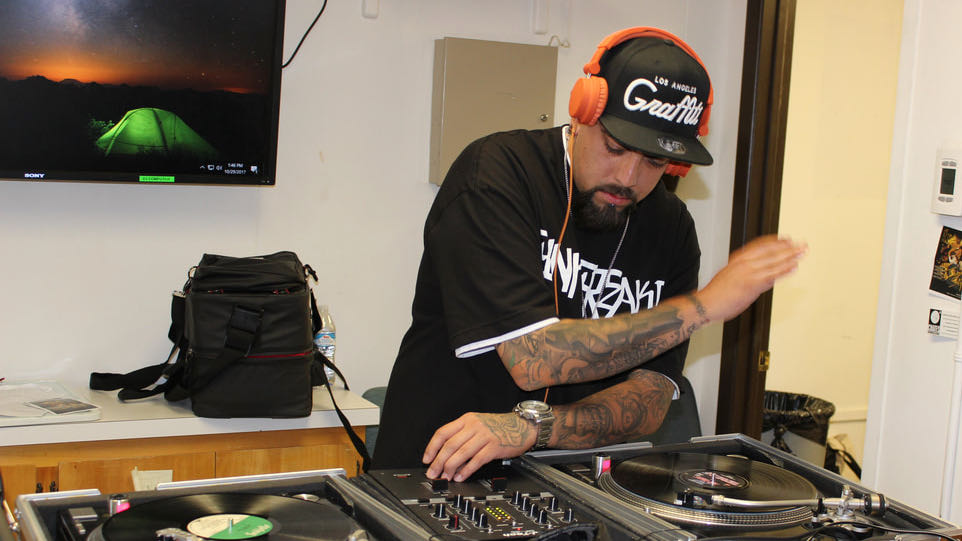How a Phoenix low-power community radio station provides ‘an institution for the institution-less’

KDIF
DJ Loser of the Funk Freaks spins on-air at KDIF in Phoenix.
A few miles and a world away from my house was KDIF 102.9 FM, a low-power FM station in South Phoenix. My drive to the station took me from the prosperous and developing parts of Phoenix to the neglected neighborhoods of South Phoenix. The streets and businesses changed as I drove further south, but my radio picked up the sound of live DJs spinning their favorite funk records instead of the syndicated religious satellite radio station. I went into KDIF thinking I would focus my dissertation on the station’s transition to digital media, but I realized KDIF and community radio were doing something more important than going digital. KDIF created a sense of belonging, and that’s something people in South Phoenix needed.
I study human communication, and I spend a lot of time explaining how communication is not quite the same thing as journalism. My research focused on social movements and digital media. My master’s thesis examined the Muslim Brotherhood’s English-language website and my interest in how groups use digital media to foster social movements. My time in the Peace Corps and volunteering for various arts and community organizations made me interested in volunteer work. I visited KDIF as part of a short class on research methods, thinking it would be a quick project. But I realized that the work of community radio was a way to connect my interests in media, volunteering, social movements and building community.
However, the most compelling lesson I took from the artists and volunteers at KDIF was how they would use community radio to build a different future for South Phoenix. The area has faced a long history of discrimination and neglect. If you’ve ever heard the term “environmental racism” — the idea that groups facing racial discrimination are forced into ecologically hazardous places — the early research that developed the term used South Phoenix as its example case. Current plans to “develop” South Phoenix focus on bringing in new, wealthy residents and businesses while failing to invest in the people already present. Local media cover some of the issues facing South Phoenix but often present the area as a hopeless place of crime and poverty. National or syndicated broadcast stations focus on news, talk and music that has national rather than local interests. Broadcast media don’t let them speak or represent them, so it should be no surprise that people in South Phoenix feel estranged from radio.
Phoenix music critics complain that most radio stations pull from the same playlists. DJ Balo agrees. “There’s a whole world of music, and people only get to hear a small part of it,” said Balo, former host of Around Da Music on KDIF and now owner of Phoenix radio station WUBI. “If the music isn’t really new or part of that 2% of old songs that get approved by big companies, it’s not on the radio.”
I think of how Anjelica, a DJ who co-hosted the all-vinyl show Rosewax Vinyl Club, talked about having the kind of music on the radio “where you can get grandmas, moms and daughters all listening together.” Commercial radio often segments by age groups, but community radio like KDIF avoids segmenting in favor of bringing people together.
KDIF’s focus is not simply local but hyperlocal. As a low-power FM station, KDIF has a broadcast radius of about three miles. Its FCC license requires that it air a certain amount of locally produced content each day. “Locally produced” means the content must be made within 10 miles of the station. KDIF is allowed to use 102.9 as a broadcast frequency, but the low-power license does not protect KDIF from interference from a commercial radio station with the same frequency.
In 2000, the FCC authorized a new class of radio stations known as low-power FM (LPFM) stations with the goal of serving small communities and underrepresented groups. Media reformers from across the political spectrum had argued that the consolidation of media outlets into few hands homogenized radio, and this homogenization reduced radio’s effectiveness as an outlet for local communities.
The LPFM designation was immediately opposed by both commercial and public radio broadcasters, and lobbying on behalf of commercial radio and NPR in Congress worked to stifle the growth of LPFM. Numerous legislators, including the late Arizona senator John McCain, spent nearly a decade struggling to define how LPFM would work. When the Local Community Radio Act of 2010 made room for more LPFM stations to get on the air, organizers in Phoenix applied for space on the dial. By 2013, the group that would become KDIF got an LPFM license to transmit in South Phoenix and parts of Downtown Phoenix. These organizers believed radio had a unique power that was most effective when it was connected to a particular geography and people.
Community radio brings people together by helping local people discuss local issues. For example, a South Phoenix high school found its mostly white faculty struggled to understand how the nonwhite students used insults and slurs among their friends. The students partnered with the station’s executive director, Franco Hernandez, to create a radio show where they could work through issues. The show gave space for students to express their concerns about losing their linguistic community, and they were challenged to consider how their language creates complexity around racial issues. Radio amplified their perspectives and provided nuance that did not take place in face-to-face conversations. The immediacy of broadcast radio forced the teachers to focus on the students as they spoke. KDIF changed the power dynamic between students and used radio to work through an issue at their high school. Syndicated national programs can’t fix issues at the local high school.
Community radio is a space where people who lack power, access or agency can speak to people in power, and community radio is the place for a community to talk with itself.
KDIF taught me how community radio fills a need that advancing commercial interests and digital audio will not replace completely. Community radio is a space where people who lack power, access or agency can speak to people in power, and community radio is the place for a community to talk with itself. “Hearing people like us on the radio when you walk into a restaurant or an auto shop,” says Hernandez, “makes you feel like South Phoenix is yours, too.” Radio’s power is to create a feeling of belonging, and community radio like KDIF supports belonging where other stations falter.
Commercial radio creates fantastic programming, but the nationalization of many commercial stations removes local character just as much as a chain restaurant. Public radio supports excellent local work, but public radio has a complex relationship with localism. Christina Dunbar-Hester, author of Low Power to the People, argues public radio lobbyists collapsed the distinction between content that serves locals and stations controlled by locals. Dunbar-Hester acknowledges comments made by public radio officials in favor of local media, but her research recognizes that public radio’s stance supports the same nationalizing and consolidating practices of commercial radio. College stations bring in new voices, but college radio ignores people over 25. Community radio is not a threat to any of these. It exists as a place for people who don’t have places in the media, and they should have a sliver of the airwaves for their church, their school, their small group of people.
KDIF is an institution for the institution-less. Sunday Service, a show no longer on the air, spent each Sunday morning pumping out funk, soul and hip-hop for gentle drives around South Phoenix avenues. “There’s organizations and places to go [to] in South Phoenix,” said one KDIF staff member, “but they only take you in if you fit a certain kind of respectability. If you’re a kid, not into church or sports, and don’t have the right background, then there isn’t a lot for you.” I sat in the studio with all kinds of people, the kinds of people who didn’t fit in other places, bopping their heads quietly to the bass. Their communion was no less valid than the religious services held in nearby churches on Sunday morning, and Sunday Service connected people in South Phoenix to each other and to people all over the world. Community radio is not just broadcast but a sense of belonging.
A feeling of belonging or connection comes through community radio, but community radio struggles to keep that feeling for long. KDIF’s hosts and staff are all unpaid volunteers. Sunday Service went off the air after its hosts moved on, but the Sunday morning time slot remains an active place for new shows and programming. Two of the three hosts of Rosewax Vinyl Club died recently, but their memory lives on at KDIF. Hernandez and a local artist turned KDIF’s lounge into the La Dama Community Lounge, an inviting space where DJs’ friends and family members can hang out while DJs host their shows. Community radio is a place where belonging and change often work together.
A friend told me that most people study something either because they want to fix the world or they want to fix themselves. I studied community radio because I thought I could “fix” this station. Every afternoon or evening, when I came home from watching a broadcast or a long budget meeting, I tuned into KDIF until the peaceful reggae mix changed into the strident monologue of the syndicated religious station that shares KDIF’s frequency. The hard part of listening to KDIF was that moment where the belonging and closeness of a hyperlocal station I felt got subsumed by a national station that didn’t care about me. I wanted that sense of community, a place where I fit in, to last a little longer. I came looking to understand belonging, but I realized I needed a place to belong, too. KDIF gave that to me in a way that no radio station has done for a long time, and belonging is something that every radio listener deserves.
Ian Derk is a lecturer in communication at Arizona State University’s College of Integrative Sciences and Arts. He teaches courses on popular culture and graphic novels. His research explores the connection between sound and community activism. He can be reached at iderk@asu.edu. You can find KDIF 102.9 online and follow it on Instagram.






